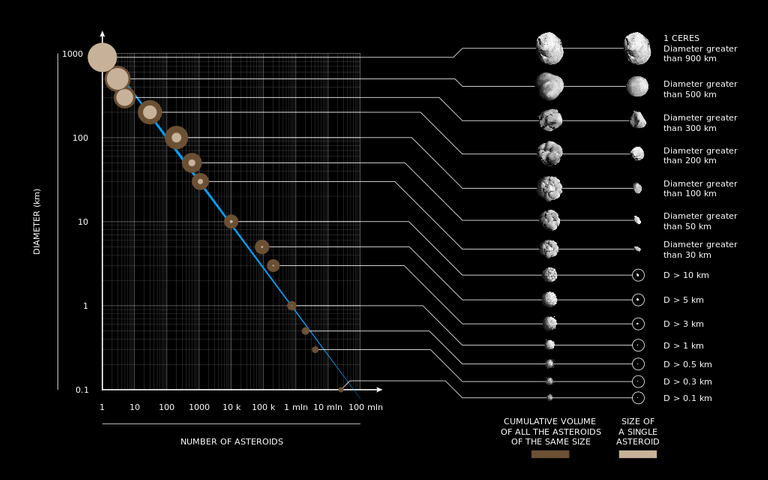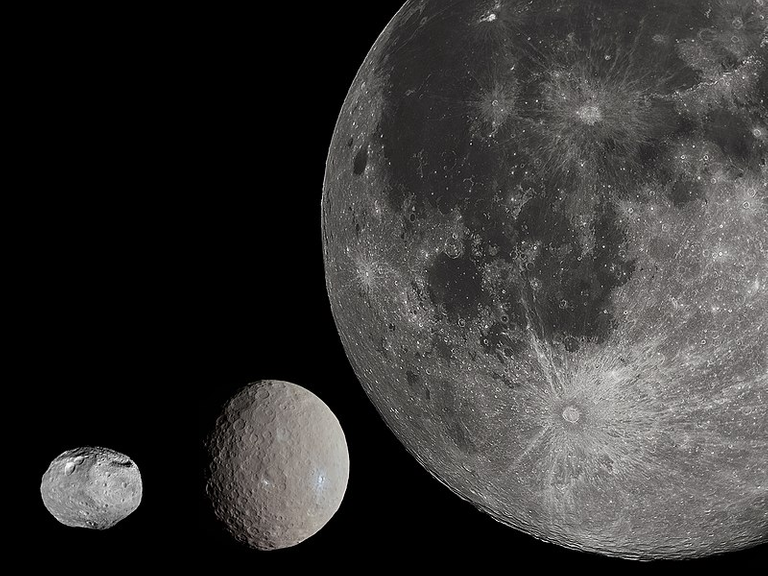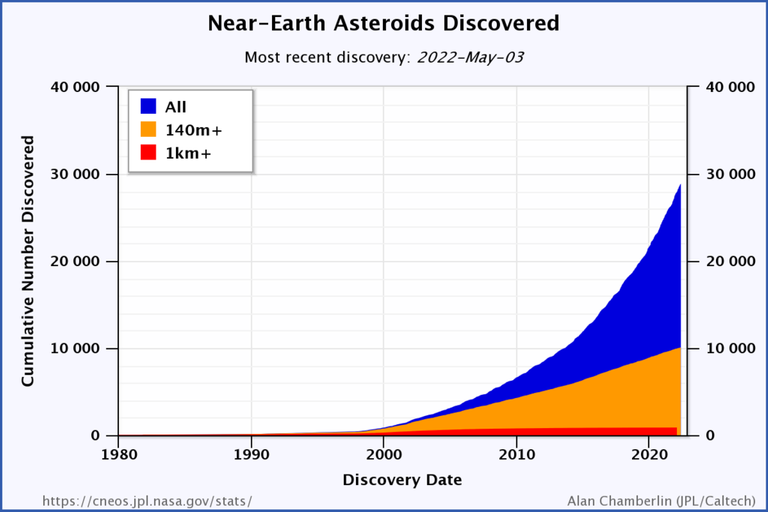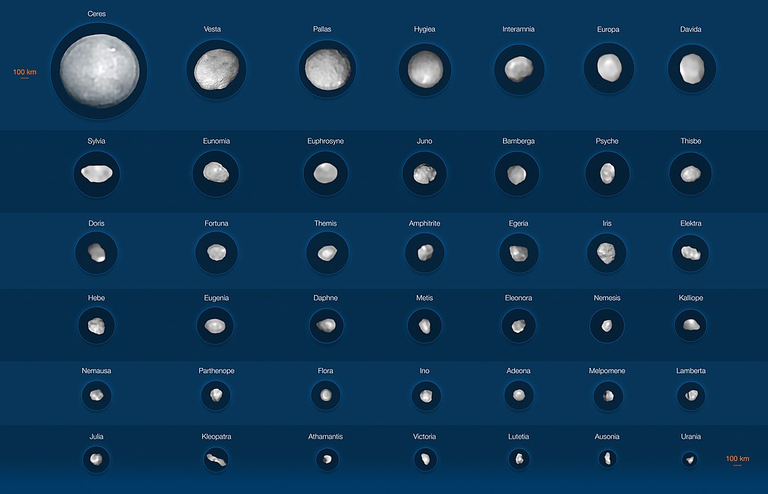Asteroid: Minor Planets or Large Rocky Monsters?

The asteroids of the Solar System, categorized by size and number
This image has been created during DensityDesign Integrated Course Final Synthesis Studio at the Polytechnic University of Milan, organized by DensityDesign Research Lab in 2015. Image is released under CC-BY-SA licence. Attribution goes to Marco Colombo, DensityDesign Research Lab.
If you want to learn more about asteroids, you've come to the right place. Here, you'll learn about their size, origin, and characteristics. You'll also learn why they're interesting and important. Then, you can use that knowledge to discover more about the universe! And if you're interested in astronomy, you'll learn about their various classifications.
About asteroids
Asteroids are irregularly shaped objects that orbit the sun. Some are as large as half a mile across, while others are quite small. They have no atmosphere, and their surfaces have a temperature of about -70 degrees Celsius. They are rich in metals, carbon, and silica. A few of them also have water trapped in their rubble mass. Astronomers believe that these objects may have been created by collisions with Earth. If that is true, then life on Earth began as a result of carbon deposits on asteroids.

By NASA/JPL/JHUAPL. Public Domain, Link
Many asteroids have moons or smaller companions. 16% of Near-Earth Asteroid Scouts (NEAs) larger than 200 meters in diameter have a companion small enough to survive an impact. Although this isn't the case right now, it doesn't mean that we can't imagine such a scenario.
After the first object was discovered in the solar system, astronomers began to study asteroids. Astronomers began observing astronomical objects, and more asteroids were discovered over the next few decades. Astronomers began to give these objects names and permanent designations. Some were named after mythological characters, such as Ceres, which is a star-like object, or Pallas, which is a small asteroid that is less than six meters in diameter.
The main belt of asteroids is home to most asteroids. These objects are made primarily of rock and metals, though some are composed of carbon and water. Several are referred to as planetoids, and the dwarf planet Ceres also lives in this belt. Asteroids in this belt are separated by approximately six hundred thousand miles. This distance is sufficient for spacecraft to explore these objects safely.
Size
There are four large asteroids in our solar system. These are Ceres, Vesta, Pallas, and Hygiea. These are so large that when they were discovered, they were thought to be planets and not asteroids. They are currently still considered by many schools of thought to be protoplanets (a hypothetical whirling gaseous mass within a giant cloud of gas and dust that rotates around a sun and is believed to give rise to a planet).

Vesta (left), with Ceres (centre) and the Moon (right) shown to scale.
Moon image: Gregory H. Revera. Ceres image: Justin Cowart. Vesta image: NASA/JPL-Caltech/UCAL/MPS/DLR/IDA - Public Domain, Link
Ceres is the largest, at just under 1000 km in diameter. Its spectral properties suggest that it is carbonaceous, and its surface is composed of hydrous silicates. However, it is not known whether it has an atmosphere or not.
The central asteroid belt is formed between the orbits of Jupiter and Mars. Thousands of other asteroids have similar sizes and shapes. These are categorized according to their chemical composition and their relative distances from the Sun.
There are over 10,000 known asteroids. Many of these are too small to be observed from Earth. Some are so small that they leave blurs on photographic plates. But, they are just as diverse as the planets. Astronomers believe that some asteroids may approach Earth in the next century. A large asteroid would release the equivalent energy of a 20,000-megaton bomb. It would also leave a 13 km crater. In addition, it would throw enough debris into the atmosphere to trigger nuclear winter.
Most asteroids are smaller than 20 kilometres, but there are large ones. Ceres, for instance, are almost 1000 km in diameter, while Vesta and Pallas are slightly larger. About 3000 asteroids are larger than 20 km in diameter. This size distribution is thought to be caused by collisional fragmentation within the asteroid belt. Because of this, meteorites that impact Earth often contain traces of collisional fragmentation.

Cumulative discoveries of just the near-Earth asteroids known by size, 1980–2022
By Alan B. Chamberlin - Jet Propulsion Laboratory, NASA. Public Domain, Link
Origin
Recent research shows that most asteroids and meteorites have a common origin. In a study published in the July 2018 issue of Nature Astronomy, Dermott and his team found that the majority of asteroids and meteorites derive from ancient minor planets. They also found that at least 15 per cent of asteroids in the inner asteroid belt may trace their origins back to the same group of primordial bodies.
The study found that the spectral signatures of asteroids reflect a cold origin. This suggests that asteroids formed much farther out from the Sun than they are today. It also suggests that the materials that formed Earth may have originated far out in space and then been brought in during the early solar system's turbulent history. The study also noted that data from NASA's Atacama Large Millimeter/submillimeter Array (ALMA) telescope have revealed ringed structures in protoplanetary disks. These results are considered to be the first direct observations of planetesimal formation.
The formation of asteroids is not completely understood. Several theories have been proposed to explain how asteroids were formed. One of these theories is that asteroids were formed from a group of particles that swarmed together in the early solar system. The proto-Jupiter and other bodies in the Jupiter zone acted as aerobraking agents for these planetesimals. This turbulent gas prevented the particles from settling down and condensed. As a result, the particles were stuck together and grew in size. This process would also add fuel to the developing asteroid.
Characteristics
Physical characterization of asteroids is a critical part of research in the space sector. Asteroids' characteristics are important for several applications, including Planetary Defence, Resources Prospecting, and Solar System formation modelling. However, most asteroids are poorly understood and there is still a lack of detailed data. This makes it difficult to use a direct experimental approach. To achieve accurate results, a variety of mathematical and physics-based approaches have been employed. For example, in this study, the researchers analysed the various factors that affect the trajectory of an asteroid, including its composition, surface temperature, slope angle, and planetary radiation pressure. They also looked at the influence of the Earth's proximity to asteroids on their trajectory.
Most asteroids are rocky bodies, and they vary in size. Some are almost a thousand kilometres across, while others are only a few meters across. The largest asteroids have partially differentiated interiors, like those of planets. However, the vast majority are much smaller. They are believed to be fragments of larger bodies and may have undergone collisions.
The large asteroids in the P and T classes have a long rotation period, while the smaller ones have shorter rotation periods. In addition, large asteroids tend to retain all of the debris from collisions, whereas the smaller ones only retain a small amount. This causes them to lose angular momentum and slow down their rotation rate.

42 of the largest objects in the asteroid belt captured by ESO's Very Large Telescope
By ESO/M. Kornmesser/Vernazza et al, CC BY 4.0, Link
Rings
Astronomers have discovered rings on asteroids in the solar system, but their origin remains a mystery. Some believe they may have been formed from debris that was thrown off the asteroid Chariklo. Another theory is that the rings were formed when another celestial body collided with the asteroid's moon, breaking it apart.
The formation of rings is a complex process, and it is not known what caused them to form. A similar process is thought to have created the moon and other planetary satellites. But whatever the case, the process of creating rings on asteroids is a mystery that must be solved. There are a variety of possible explanations for the formation of asteroids, but in general, ring formation is related to an object's mass.
Asteroids can contain a wide variety of debris, but the most likely explanation is a low-speed collision between an asteroid and a small body. The collision could have resulted in a ring system that evolved over millions of years. The shepherding moon may limit future observations, but further analysis will help us understand how the ring system formed and why other small objects might also have them.
Researchers who studied asteroid occultation observed that the star behind Chariklo shifted in its orbit. They also noticed that the star was darkened in the sky before and after the asteroid passed. They published this information in 2014, and the asteroid was renamed Chariklo.
Explosive Meteors (Bolides)
We are often in the firing line of asteroids and comets, but sometimes our planet is the target. One such event occurred on December 18, 2013, as a giant explosion erupted above the Bering Sea. The explosive growth of asteroids can result from a variety of factors.
These explosive meteors are referred to as Bolides. A bolide usually means an exceptionally bright meteor, but the term is subject to more than one definition, according to context. It may refer to any large crater-forming body, or to one that explodes in the earth's atmosphere.

Frequency of bolides, small asteroids roughly 1 to 20 meters in diameter impacting Earth's atmosphere
By NASA/Planetary Science. Public Domain, Link
Asteroids are fun to learn about, space is in general. And even though scientists speculate that a two-kilometre asteroid is unlikely to impact the Earth within the next millennium, even smaller asteroids could still destroy or injure humans. In addition, if an asteroid does strike the Earth in the next million years, it could cause a nuclear winter event.
𝙍𝙚𝙛𝙚𝙧𝙚𝙣𝙘𝙚𝙨
- "Asteroids". NASA Solar System Exploration. Retrieved 29 March 2022.
- "Asteroid or mini-planet? Hubble maps the ancient surface of Vesta". HubbleSite (Press release). News Center / Release Images. Space Telescope Science Institute. 19 April 1995. Retrieved 27 January 2015.
- SPACE.com
- Asteroid. (2022, October 7). In Wikipedia. https://en.wikipedia.org/wiki/Asteroid
- Encyclopedia of the solar system
- Woolfson, M. (2000). "The origin and evolution of the solar system"

Written by @gamsam
All images used are copyright free


Nice explanation! So why not classify some of them as planets?
!1UP
Some of them actually are referred to as protoplanets but they do not yet completely meet the criteria of being called planets. The protoplanets are just basically planets in the making but they are not yet spherical because they do not have sufficient gravity like the earth or other planets.
You have received a 1UP from @gwajnberg!
@stem-curator, @vyb-curator, @pob-curator, @neoxag-curator, @pal-curator
And they will bring !PIZZA 🍕.
Learn more about our delegation service to earn daily rewards. Join the Cartel on Discord.
Thanks for your contribution to the STEMsocial community. Feel free to join us on discord to get to know the rest of us!
Please consider delegating to the @stemsocial account (85% of the curation rewards are returned).
Thanks for including @stemsocial as a beneficiary, which gives you stronger support.